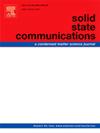One-step synthesis of dual-functional PEI/SiO2 nanoparticles for simultaneous Cu(II) ion adsorption and fluorescence sensing
IF 2.4
4区 物理与天体物理
Q3 PHYSICS, CONDENSED MATTER
引用次数: 0
Abstract
Fast analysis and adsorption removal of heavy metal ions (HMIs) are important techniques for water managements. Polyethyleneimine functionalized silica (PEI/SiO2) has been emerged as effective adsorption materials for HMIs removal but they still lack ability to monitor HMIs. In this study, we demonstrated a novel method to synthesize PEI/SiO2 nanoparticles (NPs) that are capable to adsorb and monitor Cu(II) ion simultaneously. Dual-functional PEI/SiO2 NPs were prepared by hydrothermal treatment citric acid (CA), PEI, and SiO2 NPs. Characterization by using Fourier transform infrared spectroscopy (FTIR), X-ray photoelectron spectroscopy (XPS), thermal analysis, UV–VIS absorption, and photoluminescent spectroscopies demonstrated that the obtained PEI/SiO2 NPs contained 16.4 % of PEI by weight, exhibited excitation - independent emission at 446 nm, and had overlapping absorption and excitation bands at 350 nm. Those optical properties originated from 5-oxo-1,2,3,5-tetrahydroimidazo-[1,2-α]-pyridine-7-carboxylic acid (IPCA) moieties, produced via the reaction between CA and PEI under hydrothermal conditions. The PEI/SiO2 NPs had an adsorption capacity of 53 mg/g and exhibited fluorescence sensing to Cu(II) in a 0–30 mg/L range. The results demonstrated in this study offer a unique combination of adsorption and sensing in a single inexpensive nanomaterial, creating new opportunities for multifunctional environmental materials.
一步合成双功能PEI/SiO2纳米颗粒,用于同时吸附Cu(II)离子和荧光传感
重金属离子的快速分析和吸附去除是水管理的重要技术。聚乙烯亚胺功能化二氧化硅(PEI/SiO2)已成为一种有效的hmi去除吸附材料,但仍缺乏监测hmi的能力。在这项研究中,我们展示了一种合成PEI/SiO2纳米颗粒(NPs)的新方法,该纳米颗粒能够同时吸附和监测Cu(II)离子。通过水热处理柠檬酸(CA)、PEI和SiO2 NPs制备了双功能PEI/SiO2 NPs。傅里叶变换红外光谱(FTIR)、x射线光电子能谱(XPS)、热分析、紫外-可见吸收光谱和光致发光光谱表征表明,所制备的PEI/SiO2 NPs含有16.4%的PEI(按重量计),在446 nm处表现出不依赖激发的发射,在350 nm处具有重叠的吸收和激发带。这些光学性质来源于5-氧-1,2,3,5-四氢咪唑-[1,2-α]-吡啶-7-羧酸(IPCA)部分,由CA和PEI在水热条件下反应产生。PEI/SiO2纳米粒子的吸附量为53 mg/g,在0 ~ 30 mg/L范围内对Cu(II)具有荧光敏感性。本研究的结果表明,在一种廉价的纳米材料中提供了吸附和传感的独特组合,为多功能环境材料创造了新的机会。
本文章由计算机程序翻译,如有差异,请以英文原文为准。
求助全文
约1分钟内获得全文
求助全文
来源期刊

Solid State Communications
物理-物理:凝聚态物理
CiteScore
3.40
自引率
4.80%
发文量
287
审稿时长
51 days
期刊介绍:
Solid State Communications is an international medium for the publication of short communications and original research articles on significant developments in condensed matter science, giving scientists immediate access to important, recently completed work. The journal publishes original experimental and theoretical research on the physical and chemical properties of solids and other condensed systems and also on their preparation. The submission of manuscripts reporting research on the basic physics of materials science and devices, as well as of state-of-the-art microstructures and nanostructures, is encouraged.
A coherent quantitative treatment emphasizing new physics is expected rather than a simple accumulation of experimental data. Consistent with these aims, the short communications should be kept concise and short, usually not longer than six printed pages. The number of figures and tables should also be kept to a minimum. Solid State Communications now also welcomes original research articles without length restrictions.
The Fast-Track section of Solid State Communications is the venue for very rapid publication of short communications on significant developments in condensed matter science. The goal is to offer the broad condensed matter community quick and immediate access to publish recently completed papers in research areas that are rapidly evolving and in which there are developments with great potential impact.
 求助内容:
求助内容: 应助结果提醒方式:
应助结果提醒方式:


